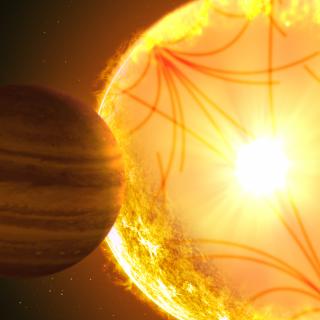Bibcode
Lipták, J.; Skarka, M.; Guenther, E.; Chaturvedi, P.; Vítková, M.; Karjalainen, R.; Šubjak, J.; Hatzes, A.; Bieryla, A.; Gandolfi, D.; Albrecht, S. H.; Beck, P. G.; Deeg, H. J.; Everett, M. E.; Higuera, J.; Jones, D.; Mathur, S.; Patel, Y. G.; Persson, C. M.; Redfield, S.; Kabáth, P.
Referencia bibliográfica
Astronomy and Astrophysics
Fecha de publicación:
10
2024
Revista
Número de citas
0
Número de citas referidas
0
Descripción
Precise space-based photometry from the Transiting Exoplanet Survey Satellite results in a huge number of exoplanetary candidates. However, the masses of these objects are unknown and must be determined by ground-based spectroscopic follow-up observations, frequently revealing the companions to be low-mass stars rather than exoplanets. We present the first orbital and stellar parameter solutions for five such eclipsing binary-star systems using radial-velocity follow-up measurements together with spectral-energy-distribution solutions. TOI-416 and TOI-1143 are totally eclipsing F+M star systems with well-determined secondary masses, radii, and temperatures. TOI-416 is a circular system with an F6 primary and a secondary with a mass of M2 = 0.131(8) M⊙. TOI-1143 consists of an F6 primary with an M2 = 0.142(3) M⊙ secondary on an eccentric orbit with a third companion. With respect to the other systems, TOI-1153 shows ellipsoidal variations, TOI-1615 contains a pulsating primary, and TOI-1788 has a spotted primary, while all have moderate mass ratios of 0.2–0.4. However, these systems are in a grazing configuration, which limits their full description. The parameters of TOI-416B and TOI-1143B are suitable for the calibration of the radius-mass relation for dwarf stars.
Proyectos relacionados
![Izquierda - Imagen RGB de la nebulosa de Orión y M43 obtenida filtros estrechos con la cámara WFC en el INT: H alfa (rojo), [S II] 6716+30 (verde), [O III] 5007 (azul). Derecha - Imagen en falso color de la nebulosa planetaria NGC 6778. En azul se ve la emisión en la línea de O II tomada con el filtro sintonizable azul del instrumento OSIRIS en el GTC; en verde imagen con el filtro estrecho de [O III] del Nordic Optical Telescope (NOT). Izquierda - Imagen RGB de la nebulosa de Orión y M43 obtenida filtros estrechos con la cámara WFC en el INT: H alfa (rojo), [S II] 6716+30 (verde), [O III] 5007 (azul). Derecha - Imagen en falso color de la nebulosa planetaria NGC 6778. En azul se ve la emisión en la línea de O II tomada con el filtro sintonizable azul del instrumento OSIRIS en el GTC; en verde imagen con el filtro estrecho de [O III] del Nordic Optical Telescope (NOT).](/sites/default/files/styles/crop_square_2_2_to_320px/public/images/project/imagen_web.jpg?itok=fsBmV9CO)
Física de Nebulosas Ionizadas
Este proyecto mantiene dos líneas principales de investigación activas: 1) Estudio de la estructura, condiciones físicas y composición química de las nebulosas ionizadas, tanto galácticas como extragalácticas, a través del análisis detallado y modelización de sus espectros. Investigación de los gradientes de composición química a lo largo del disco
Jorge
García Rojas

Sismología Solar y Estelar y Búsqueda de Exoplanetas
Los objetivos genéricos de este Proyecto son: 1) el estudio de la estructura y dinámica del interior solar, 2) la extensión de dicho estudio al caso de otras estrellas, 3) la búsqueda y caracterización de planetas extrasolares por métodos fotométricos (principalmente mediante el método de tránsitos) y espectroscópico (variaciones en la velocidad
Savita
Mathur